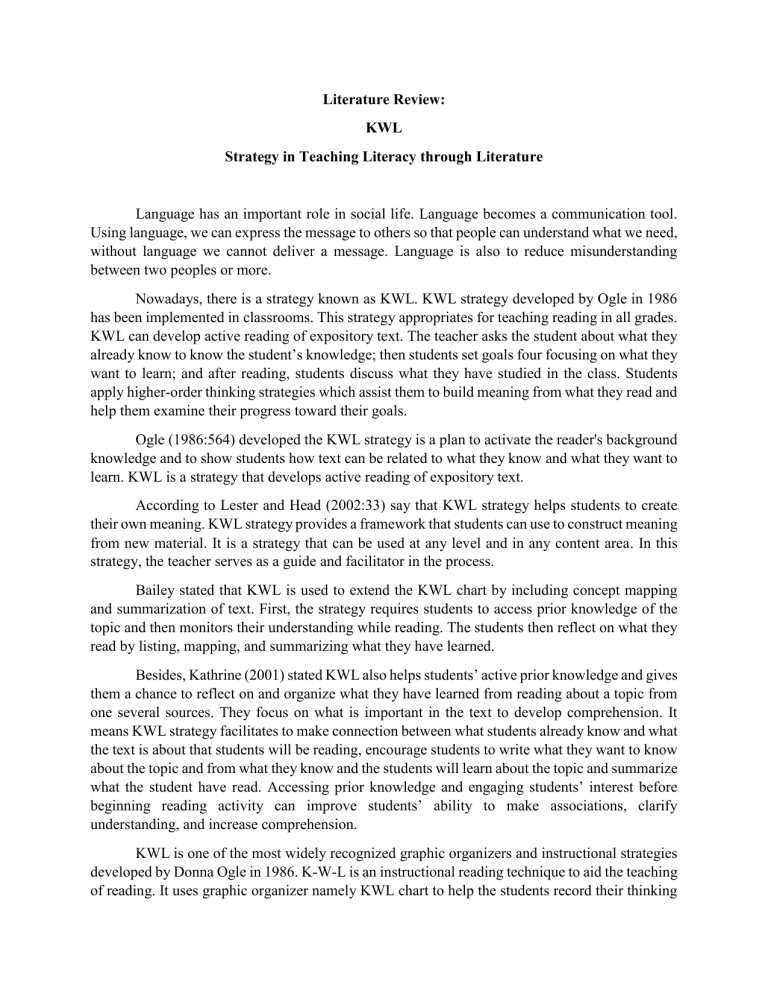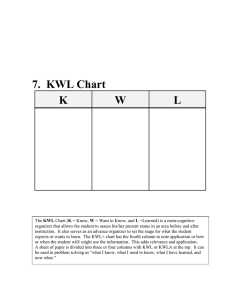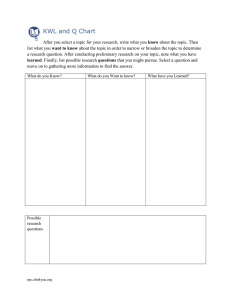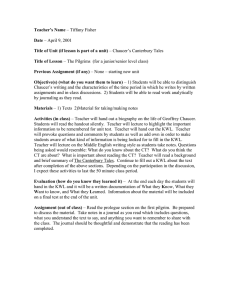
Literature Review: KWL Strategy in Teaching Literacy through Literature Language has an important role in social life. Language becomes a communication tool. Using language, we can express the message to others so that people can understand what we need, without language we cannot deliver a message. Language is also to reduce misunderstanding between two peoples or more. Nowadays, there is a strategy known as KWL. KWL strategy developed by Ogle in 1986 has been implemented in classrooms. This strategy appropriates for teaching reading in all grades. KWL can develop active reading of expository text. The teacher asks the student about what they already know to know the student’s knowledge; then students set goals four focusing on what they want to learn; and after reading, students discuss what they have studied in the class. Students apply higher-order thinking strategies which assist them to build meaning from what they read and help them examine their progress toward their goals. Ogle (1986:564) developed the KWL strategy is a plan to activate the reader's background knowledge and to show students how text can be related to what they know and what they want to learn. KWL is a strategy that develops active reading of expository text. According to Lester and Head (2002:33) say that KWL strategy helps students to create their own meaning. KWL strategy provides a framework that students can use to construct meaning from new material. It is a strategy that can be used at any level and in any content area. In this strategy, the teacher serves as a guide and facilitator in the process. Bailey stated that KWL is used to extend the KWL chart by including concept mapping and summarization of text. First, the strategy requires students to access prior knowledge of the topic and then monitors their understanding while reading. The students then reflect on what they read by listing, mapping, and summarizing what they have learned. Besides, Kathrine (2001) stated KWL also helps students’ active prior knowledge and gives them a chance to reflect on and organize what they have learned from reading about a topic from one several sources. They focus on what is important in the text to develop comprehension. It means KWL strategy facilitates to make connection between what students already know and what the text is about that students will be reading, encourage students to write what they want to know about the topic and from what they know and the students will learn about the topic and summarize what the student have read. Accessing prior knowledge and engaging students’ interest before beginning reading activity can improve students’ ability to make associations, clarify understanding, and increase comprehension. KWL is one of the most widely recognized graphic organizers and instructional strategies developed by Donna Ogle in 1986. K-W-L is an instructional reading technique to aid the teaching of reading. It uses graphic organizer namely KWL chart to help the students record their thinking process before, during, and afterreading. KWL represents a three-stage instructional process for understanding texts: what students know, what they want to know, and what they have learned (Grabe 2010:231). Based on the explanations above, the researcher concludes that this strategy is intended for use by instructors, but some responsibilities fall on students as well. KWL strategy ensures that teachers have a structure allowing students to control their own inquiry and extending the pursuit of knowledge beyond one reading selection. Students identify their own content-related questions and attempt to determine the author's purpose of reading the text. Discussion KWL is an instructional scheme that develops active reading ofexpository texts by activating learners background knowledge (Ogle, 1987). It provides a structure for recalling what learners know about a topic, noting what they want to know, and finally listing what has been learned and is yet to be learned. Learners begin by brainstorming everything they Know about the topic. The relevant information is recorded in the K column of the KWL scheme. Learners then generate a list of questions about what they Want to know about the topic. These questions are listed in the W column. During orbafter reading, learners answer these questions. What they have learned is recorded in the L column. Purpose of The KWL (Know, Want, Learn) strategy provides a structure for activating and building prior knowledge, establishing a purpose for reading and for summarizing what was learned. The strategy can help students reflect and evaluate their learning experience, as well as serve as a useful assessment tool for teachers. According to Burke (2005) KWL guides students through their reading material. Although the process begins as a before reading activity, its primary purpose is to develop a framework which students can use as they read. The procedures of KWL (Know, Want, Learned) strategy According to Ogle (1986:565) the three stages is intended to discover the following information; a. What the students Know: K stands for Know. This first stage occasionally astonishing: Think first what the students understand about the topic and make a list about that. This activity constructs knowledge of the new material. Build a scaffold to support it. Think of it as a pre-reading inventory. b. What the students Want to know. The student need to think about the text before students begin to read, each writes down on their own worksheet the specific questions that they are most interested. c. What the students Learned: L stands for Learned. The final stage is to answer the students’ questions. The sample KWL (Know, Want, Learned) strategy How Does It Work? 1. On the chalkboard, on an overhead, on a handout, or on students’ individual clean sheets, three columns should be drawn. 2. Label Column 1 K, Column 2 W, Column 3 L, 3. Before reading (or viewing or listening), students fill in the Know column with words, terms, or phrases from their background or prior knowledge. If the teachers are having them draw on a topic previously learned, then the K column may be topic-related. But if the topic is something brand-new, and they don’t know anything (or much) about it, teachers should use the K column to have them bringing to mind a similar, analogous, or broader idea. 4. Then have students predict what they might learn about the topic, which might follow a quick glance at the topic headings, pictures, and charts that are found in the reading. This helps set their purpose for reading and focuses their attention on key ideas. 5. Alternatively, you might have students put in the middle column what they want to learn about the topic. 6. After reading, students should fill in their new knowledge gained from reading the content. They can also clear up misperceptions about the topic which might have shown up in the Know column before they actually read anything. This is the stage of metacognition. (Ogle, 1986:565) The strengths and weaknesses of KWL (Know, Want, Learned) There are some strengths and weaknesses in KWL (Know, Want, Learned) strategy: No 1 2 Strengths Elicits students’ prior knowledge. • Students have to brainstorm their ideas and try to listing everything they know about the topic Easy to use and organize. Weaknesses Difficult for students with no prior knowledge • Students have a problem to listing in ‘K’ column and hard for them to have a general idea of the topic. Take time to complete. 3 4 5 • Students could divide the important and not so important points by dividing them into the appropriate column. • They could see clearly the points in order to answer the comprehension questions Sets a purpose for reading. • Readers have the idea about the text before reading the whole text. • Readers are more focus to find the important points while reading Encourage students to make a critical thinking. • Students need to fill in the ‘L’ column by thinking what they had learnt after reading the text. • Students think hard want to know more about the topic by questioning in the column ‘W’ Helps students to monitor their comprehension and knowledge. • Students know their vocabulary level and understanding ability. • Students learn new topic and put an effort to study more about the topic in order to update their knowledge. • Students have to draw the framework and use a lot of time to think about what to list in each column. • Not appropriate to use in exams because the time is limited Not effective for reading fiction materials. • Readers do not have any idea about the story or novel. So, this strategy is not suitable. Not proper for readers who has non-active thinking. • This strategy serves as a model for active thinking during reading. • So, it is not suitable for a reader who has low thinking level and poor memory skills because they will not be able to expend their ideas beyond the text. Students will give up and get bored easily. • When students fail to make a critical thinking by filling in the three columns, they would give up and refuse to complete the framework. Conclusion In general, the study concludes that KWL provides a framework that students can use to construct meaning from new material. It is a literacy strategy that teachers can easily modify to meet students learning needs at any level and in any content area.Successful learners link prior knowledge to new information, then reorganize it to create own meaning and learning. KWL strategy helps students do this. Next, KWL Strategy is a technique which will lead students to be more independent; thus, it is good to be applied in small classes as well as the big ones. It is simple, fun and arousing creativity. It is not only helpful in teaching and learning process in the classroom. KWL Strategy is also useful in other reading activities to generate and organize ideas, opinion and thoughts. It also encourages students to become involved in active thinking and cooperative learning with their classmates and It makes teacher and students become more interactive in the teaching and learning process. Finally, this study discusses the use of KWL Strategy in teaching English to improve the students’ skill especially in reading the descriptive text. It was conducted on Junior high school students. The researcher hopes that this technique can be applied by other researcher in different level of students. Considering that this study still any lack and it is just one of efforts in increasing students’ skill in reading the descriptive text, so the researcher hopes that the finding of this study will be used as starting point of the future research on similar problems. REFERENCES Ogle, D.M. (1986). K-W-L: A teaching model that develops active reading of expository text. Reading Teacher 39: 564-570. Hirsch (1988;2006) Ogle, D.M. (1989). The know, want to know, learn strategy. In K. D. Muth (ED.), Children’s comprehension of text: Research into practice (pp. 205-223). Newark, DE: International Reading Association. Ogle, D., & Carr, E. (1987). KWL Plus Strategy for comprehension and summarization, Journal of reading. P. 626-631 Katherine, A., & Stahl, D. (2004, April). Proof, Practice, and Promise: Comprehension Strategy Instruction in the Primary Grades. International Reading Association, 55(7), 598-609.


